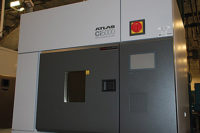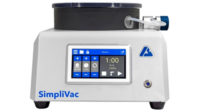With record-low winter temperatures hitting the headlines on a regular basis and outbreaks of severe cold in the northern hemisphere being linked to a ‘polar vortex,’ how are materials testing companies responding to the challenges this creates for automotive coatings?
TECH TIPSAutomotive polymer coatings are designed not only to improve a vehicle’s appearance, but to provide a protective barrier against destructive environmental forces. Environmental degradation can alter visual and physical properties such as color, gloss, shape and strength of materials used. The relative durability—and therefore quality—of materials in actual outdoor service can vary significantly in different geographical regions. |
Automotive polymer coatings are designed not only to improve a vehicle’s appearance, but to provide a protective barrier against destructive environmental forces. Environmental degradation can alter visual and physical properties such as color, gloss, shape and strength of materials used.
The relative durability—and therefore quality—of materials in actual outdoor service can vary significantly in different geographical regions because of pronounced differences in temperature, UV radiation, humidity, pollutants and other factors. When weather becomes more unpredictable, so does the reliability of automotive coatings.
This calls, then, for advanced materials testing that specifically focuses on the behavior of automotive coatings in different meteorological cycles.
Cyclic Exposure Testing: Simulation and Provisionality
Cyclic exposure testing is designed to provide a more realistic simulation of the interaction of various environmental factors. Traditional testing likely features continuous exposure to a static set of corrosive conditions.
Detrimental effects to materials to painted automotive metals can be influenced by many different factors. These include, but are not restricted to, corrosive atmospheres, rain, condensed dew, UV light, wet and dry cycling and temperature cycling.
One important thing to remember is that a controlled laboratory test environment is hardly equivalent to the unpredictable natural environmental stresses. Inherent within these tests is a ‘provisionality’ factor that must be borne in mind.
Equally, accelerated weathering tests usually involve performing exposures to an established specification, with a discussed ‘pass or fail’ criteria. The ‘pass or fail’ criteria may include visual or quantitative data. Testing requirements, even for the effects of cyclic weather exposure, tend to be delivered by the customer in terms of an exposure level—for example ‘minus 40 degrees Fahrenheit’—and a request to specifically look for effects such as warping.
Temperature and UV Cyclic Exposure
In temperature cycling tests, deleterious defects due to cold temperatures is measured, as are the potential effects of rapid temperature change, for example night-time temperature drops or polar vortex-related changes.
In some desert regions, temperature variations between day and night can be drastic. In the Sahara at a certain time of year, temperatures of over 100 degrees Fahrenheit in daylight hours can plummet to freezing conditions at night. Temperature drops are also common in cities such as Jerusalem, which is of course neighbored by the Judean Desert to the east.
Changes in temperature or humidity could potentially lead to the blistering of automotive coatings or to dimensional changes, making the testing of possible outcomes critical.
The degree of exposure to ultraviolet (UV) light, meanwhile, inflicts some of the potentially most adverse effects on automotive coatings. One of the most widespread issues in vehicle exteriors is the discoloring, over time, of paints and coatings through photodegradation from UV exposure. UV light breaks down chemical bonds in the materials used, which can result in defects such as fading, chalking and cracking.
The testing of UV exposure on automotive coatings is primarily done through a process known as ‘accelerated weathering,’ whereby environmental conditions of sunlight and moisture are simulated using specific testing chambers and instruments.
UV testing of automotive coatings is performed at elevated temperatures; the design of testing chambers does not allow for sub-ambient temperatures. However, it is possible to manually transfer specimens from the UV testing chamber to a freezer, which would be considered a type of ‘temperature shock test.’
Limitation rather than prevention is the aim in terms of quality control, since an effective coating doesn’t prevent photodegradation but simply reduces the rate at which it occurs. This means that ‘acceptable range’ delineations are used in the UV testing of coatings.
Xenon Arc Testing
Testing for the effects of weathering on automotive coatings is designed to simulate the physical and chemical stresses associated with sunlight and moisture, whose exposure is known to result in the severe deterioration of automotive coatings.
Xenon arc machines are designed to provide a reproducible controlled accelerated weathering environment. Xenon arc exposes materials to the full radiation spectrum of simulated sunlight, while environmental variables such as temperature and moisture can be controlled for more accurate real-world simulation. Water is an option and provided to thermally shock or absorb and desorb within a material. Exposure could further include cycling between wet, dry, warm and cooling, introducing mechanical stresses into the materials.
Salt and Cyclic Corrosion
Road salts used in winter to control ice and snow can further corrode automotive components. There are different types of road salts used from country to country and region to region. Some locations see the extensive use of magnesium chloride, for example, while other locations tend to use calcium chloride. Sodium acetate and calcium magnesium acetate may also be added to the mix, as well as some basic salts such as calcium hydroxide to help counter corrosiveness.
Over time, salt can penetrate coatings and corrode metal components, which in turn can lead to deleterious defects such as change in appearance, hydraulic brake system leaks, sub-frame damage and a whole host of other problems feared by vehicle manufacturers and drivers alike.
In any case, it is of course possible to design a cyclic-type corrosion test that would look at the various effects of road salts on automotive coatings.
Standardization: The Future of Cyclic Weather Testing for Automotive Coatings
The environmental testing of automotive coatings, including cyclic weather exposure testing, will continue to be led by global trends in the automotive manufacturing industry.
For materials technology organizations, this means a greater collaboration with manufacturers is required, due to an increasing need for standardized production and common standards engendered by the centralization of production and economies of scale.
Regardless of whether the world’s weather is changing dramatically or at an unprecedented pace, as suggested by the harsh winters of recent years, one thing is certain: by standardizing appropriate cyclic weather exposure testing, the automotive industry will become increasingly better equipped to serve its evolving global market.








